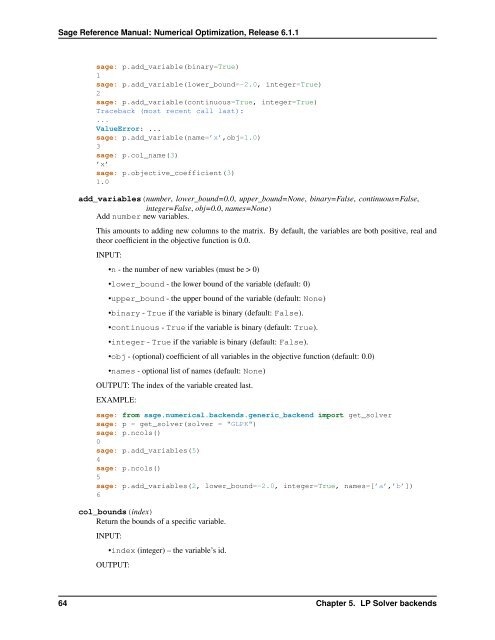Sage Reference Manual: Numerical Optimization - Mirrors
Sage Reference Manual: Numerical Optimization - Mirrors
Sage Reference Manual: Numerical Optimization - Mirrors
You also want an ePaper? Increase the reach of your titles
YUMPU automatically turns print PDFs into web optimized ePapers that Google loves.
<strong>Sage</strong> <strong>Reference</strong> <strong>Manual</strong>: <strong>Numerical</strong> <strong>Optimization</strong>, Release 6.1.1<br />
sage: p.add_variable(binary=True)<br />
1<br />
sage: p.add_variable(lower_bound=-2.0, integer=True)<br />
2<br />
sage: p.add_variable(continuous=True, integer=True)<br />
Traceback (most recent call last):<br />
...<br />
ValueError: ...<br />
sage: p.add_variable(name=’x’,obj=1.0)<br />
3<br />
sage: p.col_name(3)<br />
’x’<br />
sage: p.objective_coefficient(3)<br />
1.0<br />
add_variables(number, lower_bound=0.0, upper_bound=None, binary=False, continuous=False,<br />
integer=False, obj=0.0, names=None)<br />
Add number new variables.<br />
This amounts to adding new columns to the matrix. By default, the variables are both positive, real and<br />
theor coefficient in the objective function is 0.0.<br />
INPUT:<br />
•n - the number of new variables (must be > 0)<br />
•lower_bound - the lower bound of the variable (default: 0)<br />
•upper_bound - the upper bound of the variable (default: None)<br />
•binary - True if the variable is binary (default: False).<br />
•continuous - True if the variable is binary (default: True).<br />
•integer - True if the variable is binary (default: False).<br />
•obj - (optional) coefficient of all variables in the objective function (default: 0.0)<br />
•names - optional list of names (default: None)<br />
OUTPUT: The index of the variable created last.<br />
EXAMPLE:<br />
sage: from sage.numerical.backends.generic_backend import get_solver<br />
sage: p = get_solver(solver = "GLPK")<br />
sage: p.ncols()<br />
0<br />
sage: p.add_variables(5)<br />
4<br />
sage: p.ncols()<br />
5<br />
sage: p.add_variables(2, lower_bound=-2.0, integer=True, names=[’a’,’b’])<br />
6<br />
col_bounds(index)<br />
Return the bounds of a specific variable.<br />
INPUT:<br />
•index (integer) – the variable’s id.<br />
OUTPUT:<br />
64 Chapter 5. LP Solver backends
















